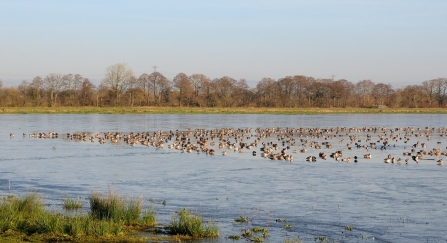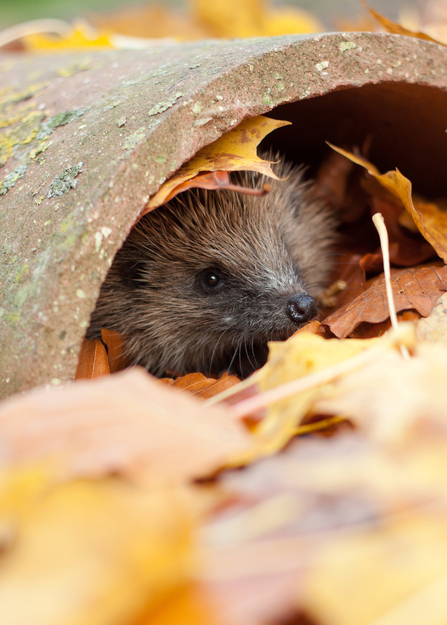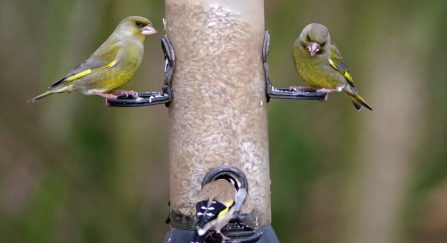As winter wildlife holiday destinations go, Somerset comes pretty high up on the list for wintering birds looking to escape colder climes elsewhere. Thousands of birds arrive in Somerset to escape cold freezing conditions elsewhere in Europe.
Where do all the wild things go?
Dense flock of Wigeon (Anas penelope) and Common Teal (Anas crecca) taking off from flooded marshes in winter fringed by Bullrushes (Typha latifolia) Somerset Levels, UK, December. - Nick Upton

Wigeon and a few Pintail, Catcott Lows - Nick Upton/2020VISION
At Catcott, wigeon arrive from Iceland while pintail and shoveler come from northwest Europe. At Westhay, bitterns arrive from eastern Europe to join our resident populations; egrets head north from France occasionally stopping here to breed; and starlings, pied wagtails and reed buntings sleep in the reedbeds, safer from predators over the water. In the other direction, during very cold weather, ducks, waders and small birds such as skylarks move out of Somerset, often reaching parts of France and Spain.
In other places in the county, for other resident wildlife species, things are far more still and quiet. As the first frosts in Mendip coat the grass and spiderwebs with a thin, white crystal crust, life is slowing down for many animals and plants.
As the leaves drop and flowering plants die off, insect life across Somerset begins to dwindle. Butterflies, such as the comma, winter in our sheds and barns. Large blues on our Green Down reserve will be overwintering as caterpillars in ant nests; Grizzled skippers on our Black Rock reserve in the Mendips will remain as a chrysalis over winter, tucked down at the base of food plants like wild strawberry.

Photo: Tom Marshall
Small animals including reptiles, amphibians and mammals have evolved to hibernate during the winter: they reduce their temperature, slow down their bodies and become inactive. Bats will use trees, caves and attics, often returning faithfully from winter to winter. They need moisture to hibernate, so caves in the Mendips are a particular favourite.
Hedgehogs sleep in dry, snug nests, amongst piles of leaves, dead branches and in scrapes under bushes - sometimes using up to four different nests during their winter hibernation. Adders seek out unused burrows and uprooted tree roots, while lizards favour spaces amongst rocks and dead wood, sleeping in small groups amongst the leaf litter. Frogs, toads and newts love the moist, dark environment under a log, rock or in a small burrow. Dragonfly and damselfly nymphs will spend the winter at the bottom of ponds and rivers.
In hibernating animals, ‘brown’ fat is laid down in large amounts in the autumn. With its own well-connected blood network, it keeps animals constantly warm and alive during hibernation. Brown fat is also essential for helping bats, hedgehogs and dormice wake up and reach higher body temperatures, particularly in the spring. What a shame we can’t use hibernation as our excuse.
But while many things are in their winter slumber, there’s still things we can do to connect with the natural world this winter….
Here’s our top tips….
1. Go Stargazing
Away from the towns and city lights, Somerset is an excellent place to look for stars, constellations and planets. Wrap up warm, take a thermos and head for more remote areas such as the Quantocks, Mendips, Exmoor and the Levels, which are particularly good places to look up at night. Brighter, larger looking stars are often planets such as Jupiter and Mars and that quick streak of light will be a shooting star...

Short-eared owl in the snow - Danny Green
2. Listen for owls
During the autumn and winter months, tawny owls are very vocal as they chase off their grown young and defend their nesting territories – if you are driving along wooded roads or walking in woods, you might spot one flying across an open space. Barn owls, short-eared owls and little owls might be seen feeding during the day flying low over long, grassy fields and little owls are often perched in an old tree with dead branches or on telegraph wires.

Birds on bird feeder -Gillian Day
3. Give wildlife a helping hand
Whilst they are out of sight, our special wildlife species shouldn’t be out of mind. There are a few small things you can do to make a big difference. Feed garden birds – food and water helps them to lay down the essential fat to survive the cold nights. While it’s not being used so much let the garden be a bit messy - piles of leaves, logs or uncut grass or plants heads such as teasels make great homes for invertebrates such as centipedes, and log piles and compost heaps are ideal for lizards, slow worms and grass snakes. If you spot a hedgehog in the winter months it probably needs your help – contact your local wildlife centres in Somerset such as Secret World and the RSPCA Westhatch for help.
4. Take a Wild Winter Walk
Wrap up and head outside to enjoy the fresh, crisp air of the countryside and explore our nature reserves when they’re at their most magical and peaceful. Head outside and get the feel good factor from our county’s stunning landscapes.

